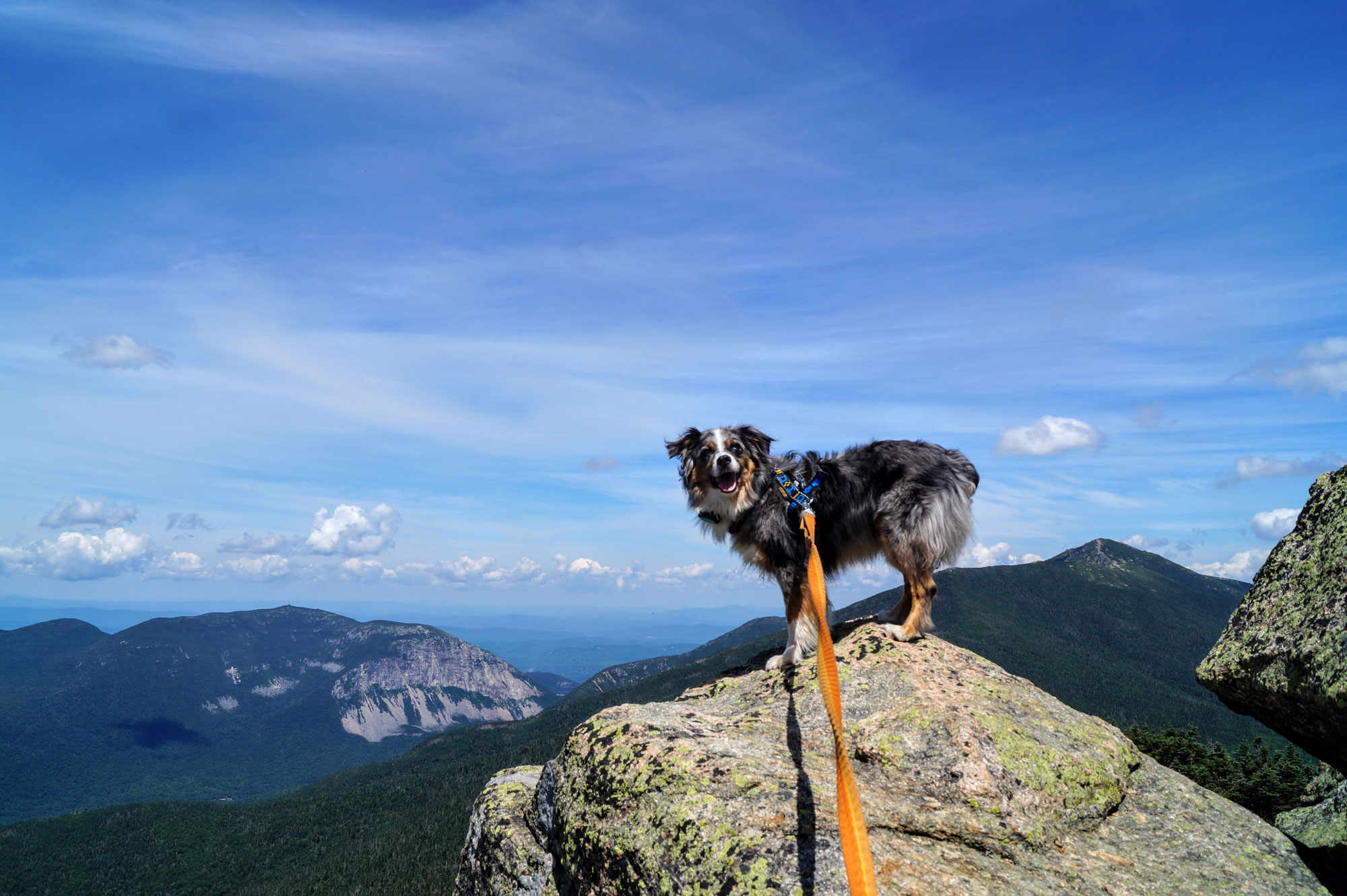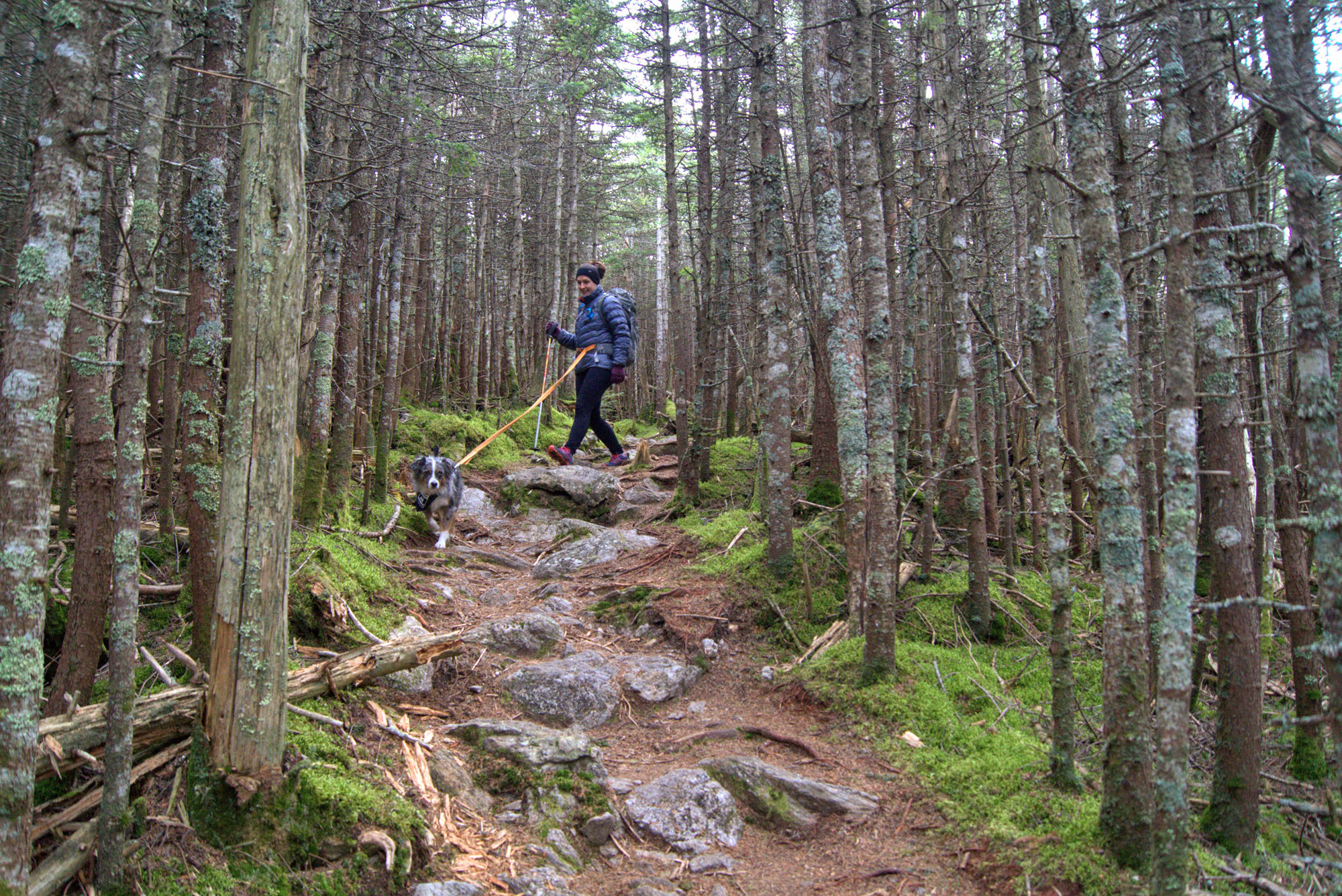In recent years, there has been a big increase in traffic on the trails of the Northeast. But it’s not just extra boots on the ground—it’s paws too, as more and more dog owners are venturing into the mountains with their four-legged friends. Adventuring with your canine can add enjoyment to an outing, but it also adds responsibility: you’re accountable for your pup’s actions as well as your own. While there is no Emily Post’s Etiquette for hiking with your pooch, following a few rules can help keep you (and them) out of the dog house.

Dog-to-Human Ratio
The key to hiking with a dog is for the person to maintain control—and the lower the dog-to-human ratio, the less likely a person is to get overwhelmed. Because it’s simply easier to manage one dog instead of multiple dogs, a one-to-one ratio is recommended.
More: Shop Dog Gear
Know Where You Can Hike
Dogs are largely welcome on the trails of the Northeast, but there are some places where you will have to leave your four-legged hiking pal at home. For example, dogs are not allowed on Mount Monadnock, in Baxter State Park, or in many wildlife refuges. However, Acadia is one of the country’s most dog-friendly National Parks, with pooches allowed on all but a few “ladder” trails. So before you go, do a little research and if dogs are not allowed at a particular destination, find another place to hike.

To Leash or Not to Leash?
Keeping a dog leashed or letting them roam free is one of the most contentious aspects of hiking with a dog—dog owners must balance their desire for their four-legged friend to have the same freedom they enjoy while not infringing on the experience of others. The rules of an area are a good starting point on whether or not you should leash your pooch. For example, in the White Mountain National Forest, dogs may hike off-leash but owners must carry one and use it at developed areas, like in parking lots and campsites.
While an area’s regulations provide a good framework for making a decision about leashes, just because dogs are allowed to hike off-leash doesn’t necessarily mean that your four-legged friend should have free reign. For example, in the White Mountain National Forest dogs must “be under verbal or physical restraint at all times.” That means when you issue a command, your dog responds the first time it’s given—if you have to repeatedly call your dog to “come,” it’s a request, not an order. Along the same lines, a dog hiking off-leash should always stay in sight of its owner; You’re not in control of your dog if you can’t see what they’re doing.
Equally important, whatever the rules permit, keep in mind that you’ll likely want to keep your pooch on a leash in environmentally sensitive areas like alpine zones as well as in areas where there are real objective hazards.
Is My Dog Able to Hike Off-Leash?
A lot of hikers love letting their dogs hike off-leash, but it’s not for everyone or every dog. In addition to exceptional obedience, an off-leash dog must be well socialized to both humans and other dogs and able to pass within close proximity of them without incident. They also must have a low prey drive and not take off after that squirrel or chipmunk you come across on the trail (nor chase after snacks from another hiker’s pack).
If you can’t decide between leash or no leash, consider that there are a lot of variables outside your control when hiking with your dog and even more when you allow them to hike off-leash. Pay attention to both the season (hunting season, for example, might not be the best time to let your furry friend have the run of the woods) and the surrounding wildlife that might see your pal as a midday snack. Finally, if your off-leash pooch really bolts, it could be a lot of work to find them again, and will most likely ruin your day.

Who Has the Right of Way?
When hiking with your dog, you forfeit the right of way and should yield to other hikers. When approaching another person or party, step aside and have your dog heel out of “sniffing” range. Keep in mind that not everyone loves dogs or wants to get sniffed, licked, or jumped on.
Communicate
The key to having a happy experience with your pup is communication, both with your dog and with others. Your dog should know what is expected of them and follow basic commands like “Come,” “Leave it,” “No,” “Sit,” and “Stay.”
Similarly, communicate about the needs of your dog to other hikers. If your dog is uncomfortable around strangers, make clear to them that “my dog isn’t friendly.” This might not tell the whole story—your dog might just be excitable or nervous—but it sends a clear message for people to keep their distance and is a good step toward ensuring a positive interaction for you, your pup, and others.
Likewise, it’s up to you to monitor your dog’s interaction with other hikers. And let’s face it—not every dog’s behavior is perfect on every outing. Whether it’s aggressively barking, growling, charging, or, in some cases, chasing, if your dog offends other hikers or interferes with their hiking experience, get immediate control of your pet and then apologize. Half-hearted statements like “he’s usually a good boy,” are excuses, not apologies, and can jeopardize access for all the well-behaved pooches out there.

Leave No Trace
We should all aspire to minimize our impact on the places we recreate and should hold our pets to the same standard. When hiking with dogs, this means picking up their poop. Dog waste contains pathogens that contaminate drinking water and nutrients that promote algae blooms and reduce oxygen for creatures living in lakes and rivers. Carry poop bags and use them. If you find the odor unpleasant, consider double bagging or retire an old dry bag or Nalgene bottle to dedicated defecation duty.
And just because your dog does its business in the first half-mile of trail, that’s not an excuse to bag it and pick it up on the way back out. You’re definitely going to forget. Either bag it and walk it back to your car, or carry it for your entire hike. Don’t leave doggy bags along the trail.
Hiking with your dog is a great exercise, an awesome way to bond with your furry pal, and a lot of fun. Following some simple petiquette will generally help to avoid any issues with other trail users, reduce your impact on the environment, and ensure everyone has a pawsitive experience.
Tim Peck and Doug Martland
Tim and Doug met long ago at the Eastern Mountain Sports in Canton, Massachusetts. Bonding over a love of slick Quincy Quarry granite, White Mountain sufferfests, and scheming up adventures while folding tee-shirts, today Tim and Doug collaborate to write about their favorite outdoor activities and occasionally get nostalgic about tee-shirt tables.
Related Posts
April 2, 2024
10 Tips for Mountain Biking Etiquette During Mud Season
One rough spring could ruin the…




